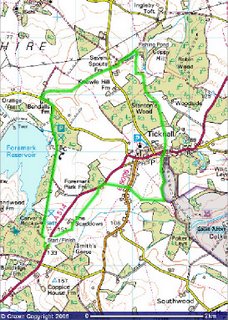It tested my faith in Rog (or my gullibility) when he suggested going to one of the most famous and stunning parts of the country on an unseasonably pleasant holiday Sunday, walking a path known as the "popular route" and asserting that there wouldn't be anyone else around. He admitted later that there were more people than he'd expected.
The walk started beautifully - just as many people around as I like (none).

From the place where we parked, we had a mile or so along a small road and then another couple of miles along a track, which turns out to be a popular cycle route, but at this stage in the morning, we were pretty much alone. The main part of this walk follows ridges and a number of peaks.

The real work started at a place known as The Gap between Fan Y Big (yes really) and Cribyn (which we immediately cristened Bernard). The picture above shows the gap (centre) and Bernard (left).

Elevenses half way up Bernard with a beautiful view of Fan Y Big (above) helped us on our way, and then a couple of false summits saw us at the top of Bernard. (below)

The next peak is Pen Y Fan, the highest peak in South Wales. What I really learned today is how different the profile of the land looks from different viewpoints. At the start of the walk, the ascent to Pen Y Fan looked vertical. However, from the top of Bernard, looking almost 'sideways on', we could see our path gently climbing to the top.
Before ascending to the highest peak, we had quite a descent to make. If you've never done it, you won't believe it, but losing 200 metres is harder than climbing the same. You use muscles in your legs that really don't get much use, and you very quickly get the wobbly legs. I discovered this in Wales last year, and had not been up and down mountains this high since then.
The climb to Pen Y Fan was reasonably gentle and I christened this one Shielopolis - partly because of the very blocky, architectural rock formations, and partly because of the large population we found up there. In the pictures below we're sitting on top of Pen Y Fan, looking away from the crowd. Yes, that's me, and it's the first time that I've had my legs on show this year. I highly recommend the kind of walking trousers that have zip-off legs - You're able to start in the morning with full trousers on, unincumber yourself when the sun is warm enough, but have those trouser legs handy in case of undergrowth or cool spells.


Up until now, we'd only really seen a few people. Getting to the top and seeing so many people really was quite bizarre.
I immediately decided that there must be a car park nearby. Rog was a little more charitable, suggesting that I give these people the credit they deserve for making the climb, but I really couldn't belive that there wasn't a car park 100 yards away. People shouting into mobile phones, young families, hundreds of dogs, chavs in track suits and trainers, enough new-lookng walking gear to stock several branches of Black's, jelly bellies, even a new baby in someone's arms. All of the signs were there.
This continued to be the case along the path to Corn Du, which looks from a distance like a 'mirror image' slightly smaller twin of Pen Y Fan. From here we could see two paths up / down being very heavily used - from high up these paths looked like two lines of coloured ants.
This picture is looking (again, away from the people) over a Cwm called Llyn Cwm Llwch.

Checking out an article in Trail Magazine later (May 2007 p118) filled in the details. 2.5 kms away are two car parks and the Storey Arms Centre. The paths are known as the Story Arms Path and Trail Magazine notes "Extremely popular path best avoided at holiday times or weekends". Don't believe anyone that tells you otherwise, as I did.
A little further on, and we were once again reasonably alone. We walked along a Craig, or ridge, scarily steep on one side, and gentle on the other.

All along this 'leg' of our horseshoe walk, we could clearly see the entire path that we had already taken. We stopped at a trig point to finish off our coffee. This is the first trig point that I've seen with a memorial plate attached. The peaks climbed earlier are behind the trig point in the distance. Notice how yellow / brown the ground is. The grass really did look thirsty, and the reservoirs that we could see down below were obviously much lower than they have been.

A very short but steep descent later and we were back at the level we'd started and less than a couple of miles away from the start.



The route and stats above were generated using Meander. The profile was generated using Tracklogs.
Image produced from the Ordnance Survey Get-a-map service. Image reproduced with kind permission of Ordnance Survey and Ordnance Survey of Northern Ireland.


























































